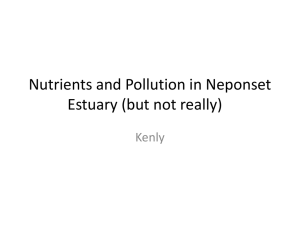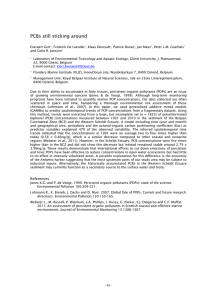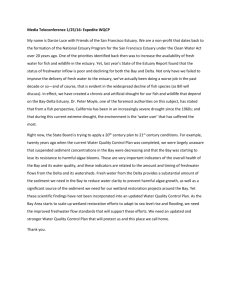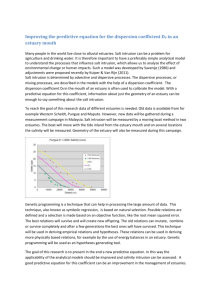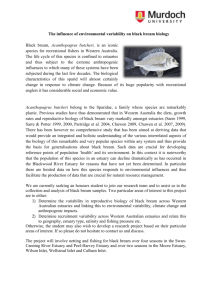HillerNeponsetReport - BIOEEOS660-f12
advertisement
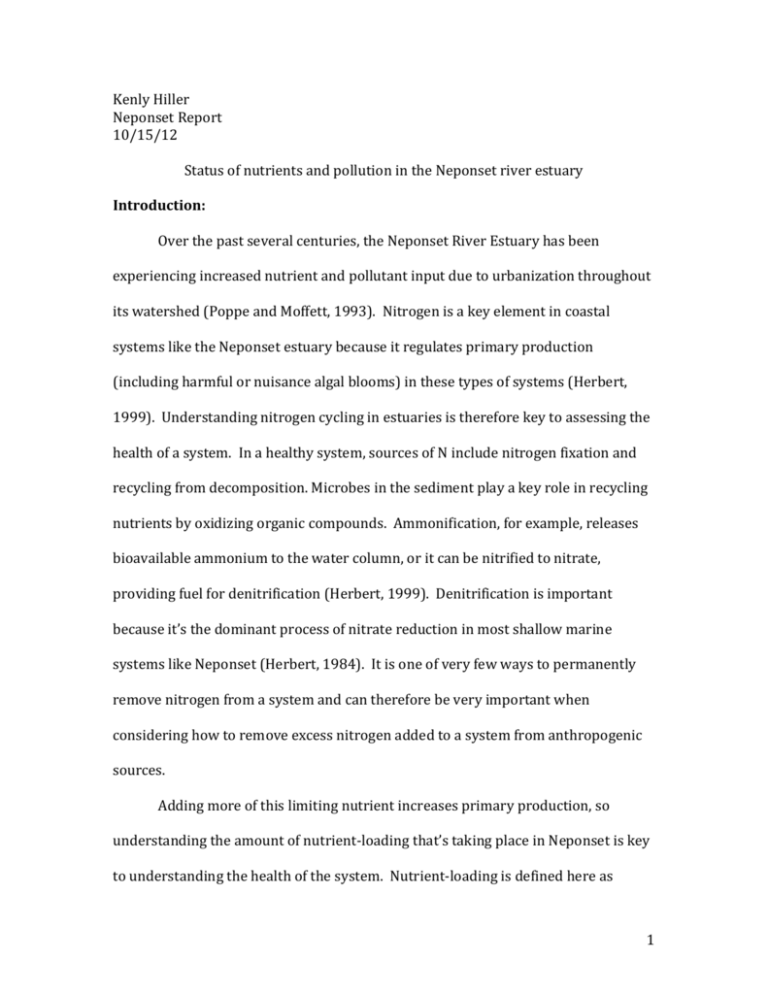
Kenly Hiller Neponset Report 10/15/12 Status of nutrients and pollution in the Neponset river estuary Introduction: Over the past several centuries, the Neponset River Estuary has been experiencing increased nutrient and pollutant input due to urbanization throughout its watershed (Poppe and Moffett, 1993). Nitrogen is a key element in coastal systems like the Neponset estuary because it regulates primary production (including harmful or nuisance algal blooms) in these types of systems (Herbert, 1999). Understanding nitrogen cycling in estuaries is therefore key to assessing the health of a system. In a healthy system, sources of N include nitrogen fixation and recycling from decomposition. Microbes in the sediment play a key role in recycling nutrients by oxidizing organic compounds. Ammonification, for example, releases bioavailable ammonium to the water column, or it can be nitrified to nitrate, providing fuel for denitrification (Herbert, 1999). Denitrification is important because it’s the dominant process of nitrate reduction in most shallow marine systems like Neponset (Herbert, 1984). It is one of very few ways to permanently remove nitrogen from a system and can therefore be very important when considering how to remove excess nitrogen added to a system from anthropogenic sources. Adding more of this limiting nutrient increases primary production, so understanding the amount of nutrient-loading that’s taking place in Neponset is key to understanding the health of the system. Nutrient-loading is defined here as 1 human additions of limiting nutrients (in this case, N) that incredase primary production from baseline levels sustained by nutrient recycling and N-fixation. Humans have increased the transfer of nitrogen through rivers like the Neponset to estuaries (Vitousek et al. 1997). Adding nitrogen causes blooms in phytoplankton that subsequently die and sink to the bottom. They are then decomposed by microbes that use up all the oxygen at the bottom, causing anoxia or hypoxia in stratified waters (Vitousek et al. 1997). The increased turbidity due to these blooms causes a loss of diversity in the primary producers that live in the estuary. Nuisance algae become dominant and the diversity of phytoplankton drops (Cosper et al. 1987). This turbidity as well as an increase in epiphyte growth due to the nitrogen surplus also causes eelgrass to die out (Cosper et al., 1987). The low oxygen and high sulfide concentrations that occur during hypoxia events significantly reduces the primary production rates of eelgrass (Holmer and Bondgaard, 2001). All of these changes resulting from increase nitrogen loads, referred to as eutrophication, have other harmful effects on the system as a whole. These changes in the species composition of primary producers in estuaries can lead to a collapse in fisheries (Vitousek et al. 1997). Fish will die if all of the oxygen is removed from the water column by microbial decomposition. Removal of oxygen also changes microbial populations and the processes like nitrification that they carry out (Herbert, 1984). Nitrification is an aerobic process and is inhibited by a lack of oxygen (Herbert, 1984). Also, the commercially relevant bay scallop population has declined drastically due to loss of their eelgrass habitats (Cosper et al. 1987). Most 2 importantly for Neponset, restoration of eelgrass will be nearly impossible if nutrient concentrations are too high. Another aspect of water quality is bacteria levels. Bacteria from leaky septic or sewer systems can leach into estuaries. These pathogens lead to an increase in waterborne gastroenteritis and therefore have hazardous effects on human health (EPA 2008). Furthermore, bacteria can be harmful to the environment because waste expelled into an estuary is broken down by microbes, which then deplete the oxygen in the system just like the decomposition of dead phytoplankton that was discussed earlier (EPA 2008). Other types of pollution can be damaging to estuarine ecosystem health as well. Polychlorinated biphenyls (PCBs) enter watersheds through waste produced by factories that manufacture elecontronics, machining, painting, and other industrial sources (Breault, 2011). They belong to a family of man-made organic chemicals used in hydraulics, electrical, and heat transfer applications because of their high boiling point and chemical stability (EPA.gov). They enter ecosystems through illegal dumping or leakages and remain there for long periods of time due to their chemical stability. They have negative effects on nearly every system in a human body, including the nervous, immune, and endocrine systems (EPA.gov). it is therefore vital to monitor the concentrations of PCBs in estuaries before any fish can be eaten, because it can biomagnify up the food chain (Perry, 2009). Heavy metal contamination can also be a problem. Mercury deposition has increased worldwide (Fry and Chumchal, 2012), and this can lead to a buildup of Hg in sediments. Depending on microbial community composition, this mercury can be 3 methylated by sulfate reducing bacteria to methylmercury (Auer et al. 2009). This form is much more toxic because it penetrates the blood-brain barrier quite easily and can biomagnify to higher concentrations in predators (Hammerschmidt and Fitzgerald, 2004). Cadmium and lead are also hazardous to human health. Cadmium emissions from batteries can leach into estuaries and can cause kidney damage if ingested (Jarup, 2003). Lead is related mainly to road transport (it used to be in gasoline) and is widespread over many types of ecosystems (Jarrup, 2003). These three metals are the most toxic and can all be harmful on human health when eaten (Jarup, 2003). Mercury and cadmium are particularly toxic to eelgrass. Concentrations of these metals were found to be up to 1,850 times higher than the surrounding water concentrations and significantly inhibited eelgrass growth (Lyngby and Brix, 1984). Monitoring heavy metal concentration is therefore another key aspect of ecosystem health to monitor when considering how to restore eelgrass to Neponset. Current Data: All sections of the Neponset River are on the water quality impaired list set out by the Massachusetts Department of Environmental Protection for organics, turbidity, low dissolved oxygen, pathogens, and metals. The actual data show that dissolved oxygen (DO) actually is not too low in the river itself. Near Foxboro/Canton the lowest DO is 6.6mg/L, and at Mother Brook only 15 of 397 samples taken had DO concentrations lower than 5mg/L (Boston Harbor Watershed, 1999). The section with the lowest DO was closest to the estuary, in the Milton to Dorchester Bay region. It went as low as 0.5mg/L at some sampling sites, 4 but it was highly variable, with some sites showing percent saturations of over 124% (Boston Harbor Watershed, 1999). The report cautions that these data were not taken pre-dawn (the time with the highest incidence of hypoxia), so they may not be representative of the true extent of oxygen depletion in the system. However, MWRA data complements this data. They found that DO ranged mostly from 59mg/L with only a few sites below 4ug/L and several above 10 (MWRA website, Fig. 1). There are many sources of excess nutrients in the Neponet watersed. Fertilizer, animal waste, runoff from impervious surfaces, direct input of grass clippings from lawns and golf courses, leaky sewers, bad septic systems, and dams all contribute excess nutrients to the system (Neponset.org). The Boston Water Quality Assessment report data show that ammonia concentrations are below the chronic water quality criteria for ammonia. Concentrations ranged from 0-0.295 mg/L, which is normal. The MWRA found that nitrate and nitrite (reported combined) in the river mouth ranges from 1-12 uM mostly, with some spikes reaching up to 30uM. Concentrations in the river itself were much higher, ranging from 20-60 uM in some sites (Fig. 2). Chlorophyll concentrations do not seem to predict nitrate concentrations, indicating that another factor (such as turbidity) might be influencing chlorophyll concentrations. However, the Neponset River Watershed Association (NRWA) stated that total nitrogen concentrations are worrisome, with 39% of sampling sites exceeding accepted nitrogen concentrations (Neponset.org). They also found that total nitrogen was most frequently excessive along the river, while nitrate+nitrite was excessive at fewer sites. It wasn’t very 5 specific information and the estuary has hardly been sampled at all. The MWRA and the data from Neponset.org only had one sampling site in the estuary itself. Phosphorus levels never exceeded 2uM, according to the MWRA website, which is fine in terms of the estuary because P is not the limiting nutrient there. However, P can be the limiting nutrient in the rivers and lakes in the Neponset watershed. In fact, NRWA found that 89% of the samples they took had total phosphorus concentrations exceeding acceptable water quality limits. They believe part of this is due to the large, historic industrial P discharge from the Foxborough Company, which is still causing eutrophic conditions in the Neponset Reservoir. Colored dissolved organic matter (CDOM) is also important because it can reduce the productivity of phytoplankton by blocking the light that is supposed to reach the photic zone (Huang and Chen, 2009). Bacteria seem to be the most pressing issue in Neponset. Reductions in bacteria loads from 72-99% are called for to even meet total maximum daily loads. These stations that don’t meet water quality standards have 200 or more organisms per 100ml sample, or more than 10% of samples from a station have counts exceeding 400 organisms/100ml. the areas of the estuary that are more developed have higher bacteria levels. This is usually due to leaking or illicit sewer connections. These issues become worse in wet weather as storm runoff flushes materials from pipe drainage systems. If the system is full of impervious surfaces like pavement, there is no chance for the soil to filter the bacteria out of the groundwater because the bacteria-laden water cannot percolate down into the soil. 6 Some segments of the Neponset River show contamination of heavy metals from wastewater discharge from companies that dump waste into the river (Boston Water Quality Report, 1999). In Foxboro, for example, Hg, Cd, Ni, Cu, Cr, and Pd are all elevated, but the report states that there is no potential for biological harm from current concentrations. Other sections of the river, such as Mother Brook, have been contaminated with Hg and Cu. High levels of polychlorinated biphenyls (PCBs) have also been found in this system. The source is waste disposal from electronics research/equipment manufacturing, machining, and painting, among other things (Brealt, 2011). There are high levels in the estuary and in fish, particularly brown bullheads (dissertation). Concentrations have been found to be as high as 26,000 mg/kg of sediment and 0.05-12 ug/L in groundwater (Brealt, 2011). Future Directions The Neponset Estuary is very neglected compared to its river. There is only one sampling site in the estuary, so water quality data is virtually non-existent. Nitrogen is most likely the limiting nutrient in this system, so we need to know how much nitrogen and subsequent primary production is in the estuary. This will allow us to determine whether nitrate concentrations in the watershed are contributing to eutrophication in the estuary itself. Knowing DO levels will be helpful too, because it will tell us if eutrophication-induced hypoxia or anoxia is occurring. Taking the same measurements in the estuary that occur in the river would accomplish this goal. Stations could be set up around the estuary perimeter as well as across the estuary itself along several gradients 7 and depths to ensure that all variations are captured. There are plenty of boaters in Neponset. If we can get volunteers to measure water quality along the river, we can probably get some for the estuary as well. With these measurements, the health of the estuary can be assessed, and total maximum daily loads for nutrients and pollutants can be established for it. Otherwise, we have no idea how inputs from the watershed are influencing the estuary. 8 Fig. 2: DO concentrations from every sample taken in the Neponset. Concentrations range from near zero to above 15mg/L 9 Mouth 10 20 Chlorophyll a (ug/L) 20 0 0 10 Chlorophyll a (ug/L) 30 30 40 40 River 0 10 30 50 Nitrate+Nitrite (uM) 70 0 10 30 50 70 Nitrate+Nitrite (uM) Fig. 2: ChlA concentrations don’t appear to be determined by nitrate+nitrite. 10 References: Breault, R.F., 2011, Concentrations, loads, and sources of polychlorinated biphenyls, Neponset River and Neponset River Estuary, eastern Massachusetts: U.S. Geological Survey Scientific Investigations Report 2011–5004, 143 p Cosper, E.M. et al. 1987. Recurrent and persistent brown tide blooms perturb coastal marine ecosystem. Estuaries and Coasts 10: 284-290. Herbert, R.A. 1999. Nitrogen cycling in coastal marine ecosystems. FEMS Microbiology Reviews 23: 563-590. Huang, W, and R. Chen. 2009. Sources and transformations of CDOM in the Neponset River watershed. Journal of Geophysical Research 114. Perry, S.L. 2009. More Than One River: Local, Place-Based Knowledge and the Political Ecology of Restoration and Remediation Along the Lower Neponset River, Massachusetts. UMass Amherst Dissertations and Theses. Vitousek, P.M. et al. 1997. Human alteration of the global nitrogen cycle: sources and consequences. Ecological Applications 7: 737-750. Total maximum daily loads of bacteria for Neponset river basin. Mass. Dept. of Environmental Protection. http://www.mass.gov/dep/water/resources/neponset.pdf Neponset river subwatershed river and estuary segment assessments. Boston Harbor Watershed 1999 Water Quality Assessment Report 11

